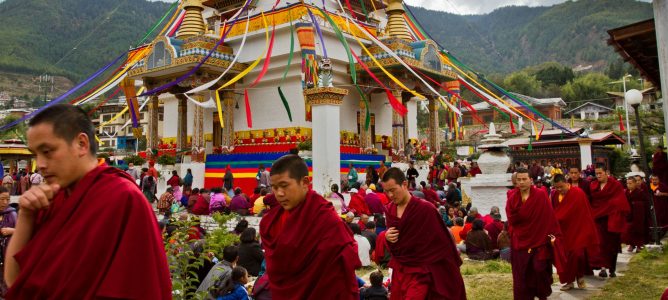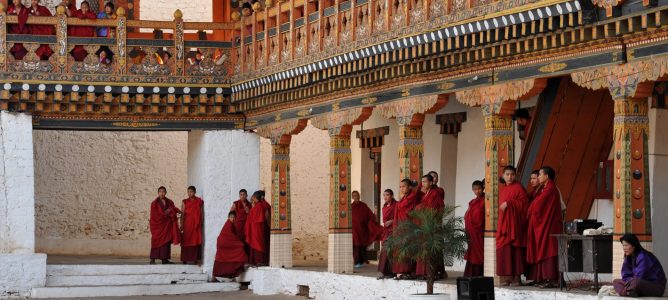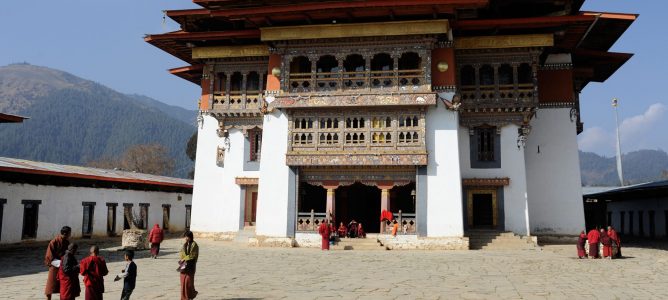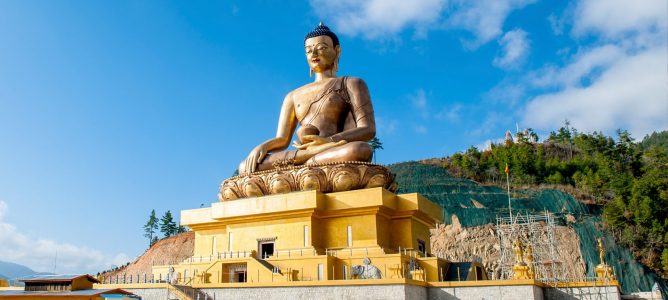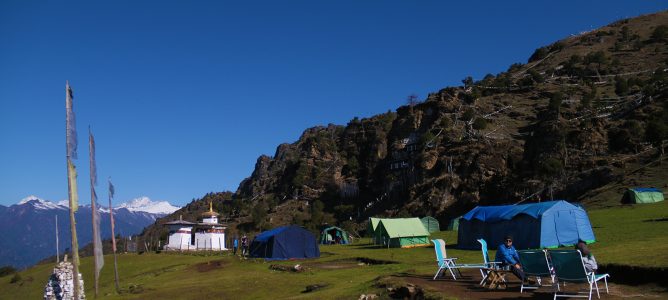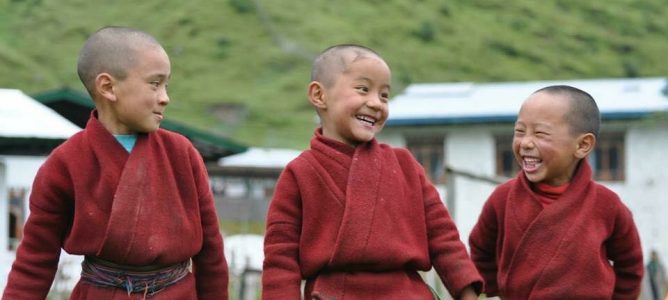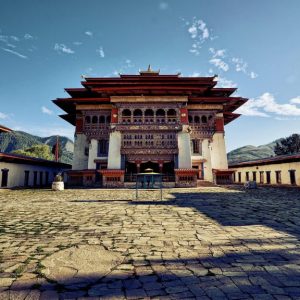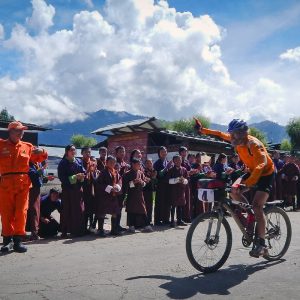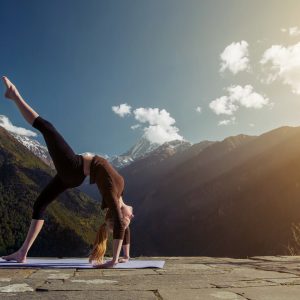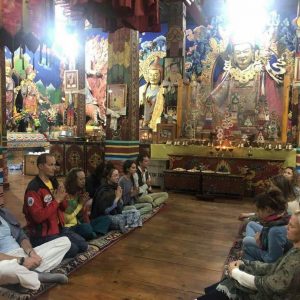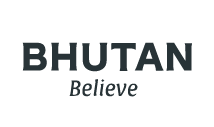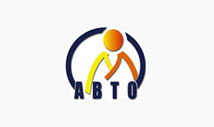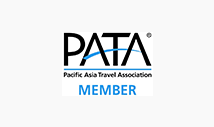Day 1: Arrive Paro
Paro Altitude: 2,250 m (7,200 feet)
Flying into the beautiful Paro valley, the clear mountain air, forested ridges, imposing monasteries and welcoming Bhutanese people in their striking national dress, provides a breath-taking first impression.
On arrival at Paro airport, you will be received by Bhutan Rila’s representative. On completion of airport formalities, drive towards Nemjo to check-in to your hotel.
Later in the evening hike up to Tsherim Temple above the hotel (around 1 hour hike up and down) or relax and rest in the hotel.
Overnight Dewachen Resort & Spa- Paro
Day 2: Paro- Bumdrak-Taksang
Bumdra – 3800m
Taksang – 3100m
Paro-Bumdrak Helicopter Ride Duration – 5 minutes.
Bumdrak – Taksang:
We will start our visit to Bumdra at 9 AM in the morning. We will be blessed by visiting the two most revered Buddhist Pilgrimage spot in Bhutan, Bumdra and Taktshang Monastery, besides enjoy the scenic beauty and Himalayan Mountains. Bumdra means ‘Rock of One Hundred Thousand Foot Prints’. The legend tells us that a hundred thousand Dakinis (angels) descended here and left their footprints on the rock 800 years ago. VisitBumdra Monastery (Cave of a Hundred Thousand Prayers).
After tea, we will start our trek to Paro via Taktshang Monastery. After one to two hours of descent we catch glimpses of the golden roofs of temples below. The path snakes across the mountainside between these monasteries before reaching the gardens of Zangtopelri (Heaven on Earth), from here you get views of the Taktsang Monastery.
An hour later you reach Taktsang Monastery. You can have your picnic lunch at the viewpoint and further walk down hill for an hour will reach the road head where your vehicle will be waiting for you.
Later in the evening experience traditional bhutanese herbal hotstone bath in the hotel
Over night at Paro.
Day 3: Paro-Bumthang
This region that spans from 2,600-4,500 m is the religious heartland of the nation and home to some of its oldest Buddhist temples and monasteries. Tales of Guru Padmasambhava and the tertons (“religious treasure-discoverers”) still linger in this sacred region.
Overnight in Bumthang
Day 4 Bumthang- Local Sightseeing
This morning, you will embark for local sightseeing in the beautiful Bumthang Valley. You will visit three ancient and sacred monasteries, JambayLhakhang, KurjeLhakhang, and TamshingLhakhang. TamshingLhakhang is of particular note because, in March 2012, the monastery was submitted for inscription on the UNESCO World Heritage List.
After lunch visit ChakarLhakhang (The Iron Castle) ,JakarDzong and Bumthang Brewery and Cheese Factory.Evening Relax in the hotel or take a walk.
Overnight in Bumthang
Day 5: Bumthang- Tang Kuenzangdrak –Retreat
To visit Tang Valley you have to drive from Jakar towards the west-east road that goes to Ura for 10 KMs. Then through the unpaved roads you will finally reach this beautiful valley. This is the road which can take you to the burning lake (Membartsho) and PemaTekchokChoelingShedra.
You will visit PemaThekchok Nunnery join the nuns for a specially organized for your group- Chöd or Chod Ritual is a unique spiritual practice and a path to complete enlightenment, by cutting through attachment to the body to offer compassionate sacrifice, so that in wondrous application of wisdom and compassion all things unite. Chod is a powerful Buddhist tantric practice. In Tibetan Buddhist Tantra it is taught to beginners for accumulation of merits.It clears the karmic obstacles and blockages arising from our negative interaction with others in countless past lives. Harming others through physical, verbal or emotional aggression results in a karmic seed, which ultimately ripens in various sufferings of body and mind. Chö or Healing Chod Puja is a unique spiritual practice and a path to complete enlightenment.
After lunch hike upto Tang KunzangdrakGoempa founded by PemaLingpa on a cliff above the road. A stiff 45-minute hike up the hillside above Drangchel village leads to one of the most important sites related to PemaLingpa. He began construction of the goemba in 1488, and many of his most important sacred relics are kept here.
The first chapel, WangkhangLhakhang, has a kora path around it, suspended in mid-air, with Chenresig, Guru NangsiZilnon (Guru Rinpoche) and his disciple NamkhaiNyingpo inside. Walk around the back of the building to the gravity-defying KhandromaLhakhang, the meditation cave of YesheTshogyel, spectacularly situated against a vertical rock face that seeps holy water. Ask to see the woodblocks and stone anvil bearing the footprint of PemaLingpa.
Overnight in Retreat Cabin. Please note that the facilities here are very basic and remote.
Later in the evening attend one hour teaching and meditation guided by the head Lama.
Day 6: Tang Kunzangdrak- Bumthang
Early Morning at 6 AM join the monks for smoke(Sang) offering and a cleansing ceremony.Sang pūjā is a profound Vajrayāna offering practice. The word Sang in Tibetan has the meaning of remove, take away; purified, cleared, cleansed and awakened. As such Sang pūjā is considered a purification practice and focuses on removing the impurities in the mindstream of the practitioners and all the ‘guests’ .The physical ritual involves the burning of different woods, incense together and many other substances such as ground gemstones and brocades that are described in the practice texts.
After breakfast we will return back to Bumthang. On the way back we will visit Tang Ugyen Chholing Musuem and try the local Bumthangpa home cooked delicacies for lunch and on the way back we will also visit the Burning Lake and offer butter lamps.
Evening Relax and free time.
Dinner in the hotel. Overnight at Yugharling Resort.
Day 7: Bumthang-Gangtey
Bumthang –Trongsa: 2 Hours
Trongsa-Gangtey: 3 Hours.
PHOBJIKHA/GANGTEY: 3,000 m (9,840 feet)
After breakfast start our jouney towards Gangtey. On the way visit a local Yathra( Yak Wool) products weaving center . Visit Trongsa Dzong which was built in 1644, used to be the seat of power of the Wangchuck dynasty before they became rulers of Bhutan in 1907. Traditionally, the King of Bhutan first becomes the TrongsaPenlop (governor) before being named the Crown Prince and eventually the King. Built on a mountain spur high above the gorges of the MangdeChhu, the dzong controlled east-west trade for centuries. Trongsa also boasts an impressive museum. The watchtower of Trongsa has been converted into a museum dedicated to the Wangchuck dynasty and is a good place to learn about the history of the kingdom
After lunch drive to Gangtey/Phobjikhavalley .This valley is a broad glacial valley (10’000 ft) on the flanks of the Black Mountains, Phobjikha with it’s gently slope is a place of astonishing beauty described as” the most beautiful valley in the most beautiful country of Himalayas”. Every winter, the rare and beautiful black-necked cranes return from Tibet to the Gangtey valley where they are protected.
Overnight in Gangtey
Day 8 Gangtey
After breakfast drive uptoGangtey Monastery. The GangtengMonastery ,generally known as GangteyGonpa or Gangtey Monastery, is an important monastery of Nyingmapa school of Buddhism, the main seat of the Pema Lingpa tradition. The Monastery’s history traces to the early 17th century and back to the prophecies made by the well-known Terton (treasure finder) PemaLingpa in the late 15th century. The present Abbot, KunzangPemaNamgyal is the ninth re-incarnation. The descent of the first king of Bhutan, Ugyen Wangchuck of the Wangchuk Dynasty of Bhutan, which continues to rule Bhutan is traced to the clan of the DungkharChoje, a subsidiary of the clan of KhouchungChoje whose founder was KungaWangpo, the fourth son of Pema Lingpa.
Here we will offer 1000 butter lamps and then we will visit the monastic college or shedra, Do-ngagTösamRabgayling and receive one hour teaching on Buddhism and a short Meditation Session.
Later hike through the beautiful Gangtey trail and check in to Dewachen Hotel & Spa. Evening relax / free time to walk around or try Hot Stone Bath in the Hotel. Dinner in the Hotel
Day 9: Gangtey-Punakha
Gangtey-Punakha:3 Hours
Punakha Altitude:1,300 m
After breakfast drive to Punakha. Visit the very impressive PunakhaDzong which previously served as the seat of the government. PunakhaDzong is still the winter residence of the Dratsheng (Central Monk Body) and holds the title as the winter capital because of its more temperate climate. This afternoon enjoy a fascinating hike through fields and small hamlets to KhamsumYulleyNamgyelChorten.This beautiful structure was built by the current King’s mother for his protection from evil.
Evening relax in the hotel or free time to walk around.
Overnight at Punakha
Day 10:Punakha-Thimphu
Punakha-Thimphu: 2 & half Hours.
After breakfast drive back to Paro.On the way visit ChimiLhakhangwhich was built by Lama DrukpaKuenley {popularly known as “The Devine Madman”} in the 15th Century. He subdued the demons with his “Magical Thunder bolt”. The Temple is also known as “the Temple of Fertility”.The divine madman is a famous teacher with whom the phallic symbol is associated. Tales told by your guide would have excited you to visit ChhimiLhakhang. The Divine Madman sits there though a statue this time. Do not miss the master’s deeds painted on the walls. Japanese and several American couples visited this temple and were blessed miraculously with children.
Stopover at Dochula .Dochula Pass is one of Bhutan’s most famous sites, perched at an altitude of 10,200 feet and located along the road from the country’s current capital of Thimphuto its former capital Punakha. A hidden surprise awaits the few who take the time to venture away from the touristy hub.These curious visitors will discover the meditation caves tucked into the hills just above the pass. At first resembling Hobbit homes, these tiny, open-faced caverns are built from stone and painted in colorful detail with Buddhist symbolism. The druk, or dragon—Bhutan’s long-time national symbol and spirit animal—stretches over the cave entrance, bringing good luck and good tidings.
Later in the evening in Thimphu visit The National Memorial Chorten and TashichhoDzong- The Fortress of the Auspicious Religion and office of the Golden throne of the Dragon King of Bhutan. Join Kevin in offering 108 butter lamps and long life prayers at ZangthoPalri Temple in Thimphu. Also visit the Takin preserve centre and Sangaygangview point.
Over night in Thimphu
Day 11: Thimphu- Hike to Tango Monastery
After breakfast hike to Tango Monastery-Set around 14 kilometres away from the city centre, the Tango Buddhist Institute is a place of serenity set in the picturesque valley of Thimphu. Founded in the 13th century by the much revered Lama GyalwaLhanampa, the three-storey monastery houses a number of remarkable statues. The ground floor has a huge statue of the Buddhu made of gold and copper, and houses the Trulku temple for worshipping the Buddha. The temple can be reached through a half day hike through the scenic mountains and alpine woods, which is one of the most exhilarating hike.
After having lunch at the Folk Heritage Musuem restaurant, visit the National Library of Bhutan, known as NLB, was established back in 1967 and is one of the largest collection of literature on Tibetan Buddhism anywhere in the world. It has as many as 6100 books and manuscripts in Tibetan and Bhutanese, and holds over 9000 printing blocks used to create religious texts. The pretty two-storey building is a must-visit on the list of Thimphu things to do.
Later in the afternoon try making Bhutanese paper at Jungshi Handmade Paper Factory- Called Deh-sho, Bhutanese paper is made from the local trees of daphne and dhekap trees. The Jungshi factory is reputably the best place that manufactures this type of paper, made using an age old method instead of the modern way. Visitors to the paper factory are given a demonstration of the paper making process, and they are also invited to try their hand at some of the unique instruments. One of the most popular things to do in Thimphu, you can buy this unique paper here which will make for interesting souvenir gifts.
Overnight in Thimphu
Day 12: Thimphu- “Hapiness Tree” Plantation in Thimphu
After early breakfast as part of our eco tourism initiative- we will drive to KuenselPhodrang to Plant “Happiness Tree “ one by each visitor at the KuenselPhodrang Happiness Garden to promote our natural environment and to offset some of the carbon emissions from your travels while having fun. The endemic tree saplings are taken care of until they reach maturity. A unique alternative to the typical Bhutan trip, the Happiness Tree Plantatis sure to be memorable as visitors have the chance to plant a “tree for Happiness”, their very own green thumb mark on the mountain of Bhutan and walk through the KuenselPhodrang walking trail to ChangangkhaLhakhang.
The oldest place of worship in the capital, ChangangkhaLhakhang is located on a small hill some kilometres from the city centre. The shrine houses a brilliant statue of Chenrizig who is thought of as an incarnation of Avolokitesawara, one of the central gods in Bhutanese Buddhism. For tourists, the monastery, located at the top of a hill, provides a great vantage point on the beautiful Thimphu valley.Shop at the weekend vegetable market.This is an enormous event in the everyday life of the people in Thimphu and one of the most fun things to do in Thimphu. Sellers flock to the city right from Thursday evening and only leave late Sunday. You can find all kinds of Bhutanese delicacies here, and homemade cheese and dried fish is something that you have to try if you are serious about local cuisine. Shopping in Thimphu does not get better than this with the various local incense sticks and large cubes of excellent saffron used for pilgrims
Evening explore Thimphu at your own.
Day 13: Thimphu-Paro
Before leaving for Paro visit the Royal Textile Academy of Bhutan and the Weaving is one of the oldest Bhutanese crafts, and the Academy, housed in a beautiful contemporary building, attempts to preserve this heritage and also work for the empowerment of Bhutanese women by training them in this much valued craftsmanship. The exhibitions here show the various elaborate clothes made for the royal family by workers here. The place is another hidden gem and one of the top things to do in Thimphu.
Then visit Postal Musuem. The postal museum narrates the story of the evolution of communication, transportation and postal services in Bhutan’s history. Its five galleries trace the development of the Bhutanese postal system, from the earliest mail runners to Bhutan’s idiosyncratic and highly collectable modern stamps
After lunch drive to Paro. On the Way TachogLhakhang. Tachogang means ‘temple of the hill of the excellent horse’. It is said that while ThangtongGyalpo was meditating here, he had a vision of the spiritual horse Balaha-an emanation of Avalokiteshvara. He decided there upon to build a temple at this spot, in addition to one of his famous iron bridges later carried away by floods in 1969. A traditional style bridge with iron chains was restored in 2005. The temple is privately run by the descendents of ThangtongGyalpo.Later in Paro visit KyichuLhakhang, RInpungDzong and National Musuem of Bhutan.
Check in to Dewachen Resort. Evening free time to explore and walk on your own.
Day 14: Paro-Chumphu Hike- Paro
Duration: 7-8 Hours (Going & Return).
Chumphu is in Paro, the western District of Bhutan.After leaving your vehicle at the end of the road, the walk is casual and not too tiring as the hike path goes through the forests so there is a lot of shade and cool breeze.From here on its a medium to steep climb up to the Temple where the “DorjiPhamo – The flying Goddess” Or the “floating” statue is situated. DorjiPhamo is also known as DorjePhamo or Vajravarahi.This statue is very sacred and ancient as its believed that the Goddess DorjiPhamo flew from Tibet and stayed on in the form of a statue. She is a life size statue and believe it or not, her one leg is crossed at the knees and the other is standing but does not touch the ground.
Some people test this belief by passing a money note below her feet and it passes through smoothly without a hitch. The other site to visit at Chumphu is the Guru Rimpoche Caves. There are several caves used by Guru himself and some caves used by his consorts like KhandomMendharawa and KhandomYesheyTshokey.
There are water falls said to be the bathing place of Guru Padmasambhava and there are big rock opening said to be the opening gates to Heaven.The peace and joy you feel visiting this temple is just amazing and calming to the mind and soul.
Evening explore Paro town for souvenir Shopping or relax in the Hotel. Dinner in the Hotel with Cultural Program.
Overnight in Paro.
Day 15: Depart
After breakfast an early morning transfer to Paro Airport for your onward flight. Thank you for visiting Bhutan.

